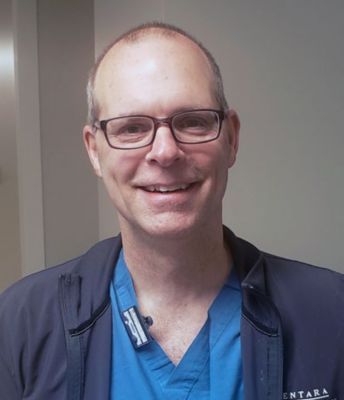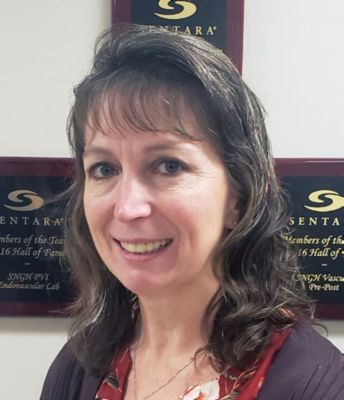
Putting quality and efficiency first: Azurion helps an interventional department grow
- By Philips
- Featuring
- March 17 2025
- 8 min read
As part of a $200 million hospital-wide renovation, the Vascular Surgery and Interventional Radiology departments at Sentara Norfolk General Hospital were instructed to combine forces and expand their capabilities. The move to a newly renovated space provided an excellent opportunity to outfit procedure rooms with technology able to perform to the level of service required of a rapidly growing department. “We were given a blank canvas,” says Dr. Christopher J. Dobzyniak, chief of Interventional Radiology.
At-a-glance:
- Selecting interventional imaging technology to support growing service lines
- Physician perspective on the benefits of 3D imaging tools
- Efficiency improvements enabled by the Azurion user interface and workflow features
- Mitigating concerns about excessive X-ray exposure with dose management technology
- Administrator perspective on throughput improvements
- Results: reduced procedure times, increased throughput, and improved staff morale"

Dr. Dobzyniak continues, “We wanted to find technology that would allow us to be as efficient as possible, minimize our case time and allow us to deliver the best outcomes achievable.” Ultimately, Norfolk General acquired four Philips Azurion interventional X-ray suites to fulfill their requirements. In place for two and a half years, the systems have demonstrated the ability to support the most complex challenges of both vascular surgery and interventional radiology.
Dr. Dobzyniak suggests, “Azurion’s quality has really allowed us an increased sense of confidence that we’re doing the right thing at the right time and that we’re going to have a great patient outcome.”
Poised to succeed
As the region’s first Magnet Hospital, Sentara Norfolk General Hospital is a 525-bed tertiary care facility and level-one trauma center in Norfolk, Virginia, with a growing referral reach that expands down into North Carolina and up to Northern Virginia. Norfolk General’s 12 sister hospitals add to that strong referral base.
“One of the things we were looking at as we were designing our new department was patient throughput,” says Dr. Dobzyniak, and “how we were going to accommodate the number of patients that we had, not only at that moment, but as our volume increased over time. It seemed Azurion was the answer.”
Eight new procedure rooms with equipment dedicated to vascular surgery, interventional radiology and neuro-intervention were created – four single plane Azurion systems (two for IR, two for vascular surgery), one biplane system, one CT, one Ultrasound and one non-imaging room for minor procedures.
“All of the clinical capabilities we were hoping would be improved, seemed to be exactly what Philips was already working on with the Azurion system,” says Hope Wolfe, director of Vascular and Interventional Radiology. “While we spent months doing our due diligence, it was an easy and unanimous decision in the end.”
Support for an oncology focus
Interventional Oncology is a large portion of Norfolk General’s IR practice. It is the only facility within 150 miles with an extensive oncology department and so have been able to develop a significant practice around embolization, chemoembolization and radioembolization. Azurion’s portfolio of clinical tools, including EmboGuide, 3D Roadmap and XperGuide, assist the staff in these procedures.
EmboGuide is a workflow-based tool to guide detection and treatment of tumors and feeder vessels to multiple lesions. Based on a segmented 3D volume, EmboGuide automatically analyses the vasculature of lesions and provides suggestions about small feeder vessels to the segmented lesions.
“EmboGuide is a profoundly exceptional tool,” says Dr. Dobzyniak. “It is something very unique with respect to the Philips machine. It allows us to significantly decrease the procedure time, which helps expose the patient, the doctors and the staff to less radiation. In addition, it increases overall procedure efficiency. The patient is on the table for a shorter period of time, so there’s less risk of complications, less discomfort and it becomes an easier situation.”
“The beauty of EmboGuide is that you can position yourself within the vasculature, do one run and say ‘OK, that’s the vessel I need to get to’ and then you spend just a few minutes getting to the culprit vessel. You go from ‘I think that’s it,’ to ‘I know that’s it.’”
“From a liver oncology standpoint, if we can be selective and treat small segments of the liver instead of the whole lobe, we can deliver our embolic agents in a more targeted fashion. We can get patients to a point where they can undergo definitive surgical management or ablation management, or get them to transplant more quickly. If they come back with additional lesions, most of the liver is going to be virgin and will allow us to treat in a new area rather than have to question as to whether we will over-treat and potentially cause the patient harm.”
EmboGuide is a profoundly exceptional tool…It allows us to significantly decrease the procedure time, which helps expose the patient, the doctors and the staff to less radiation.

Christopher J. Dobzyniak MD
Chief, Interventional Radiology
Sentara Norfolk General Hospital
A case study
A few short months after the new Azurion labs were up and running, an older gentleman who had had a right nephrectomy presented with renal insufficiency in his remaining kidney and a bleeding transitional scirrhous carcinoma in his renal pelvis – he was unstable.
Dr. Dobzyniak recalls, “My partner from one of our sister hospitals performed a CTA on the patient to determine the source of the bleeding and found he couldn’t see anything. So they considered having end-of-life discussions. Ultimately, we had him transferred over to Norfolk General where we did a CT with the intent to use image guidance tools on the Azurion system.
“What we found was one little vessel that was going into this bleeding tumor that we never would have seen without Azurion image guidance tools. We catheterized that branch, I put one coil in, and his bleeding stopped. He went home two days later. This is a guy who was either going to end up on life- long dialysis or go to hospice.”
3D Roadmap guides users through vasculature during the entire procedure, thereby reducing the need for a conventional contrast enhanced roadmap. It provides live 3D image guidance for navigating vascular structures anywhere in the body by overlaying real-time 2D fluoroscopy images and an acquired 3D reconstruction of the vessel tree.
According to Dr. Dobzyniak, “3D Roadmap is something we are beginning to utilize more and more as the prostate embolization part of our practice grows. The pelvis is a relatively stationary structure, so the 3D Roadmap is very consistent in that area. We are able to do one run, step back and let the software package do its thing. We get a good lay of the land, understand exactly what the anatomy looks like, and then import that image and use it to guide our catheter right into place – very simple.”
“Using clinical tools like EmboGuide and 3D Roadmap guides us to the proper place quickly instead of doing 5, 6 or 7 runs.” XperGuide offers live 3D image needle guidance, bringing percutaneous needle procedures into the interventional lab. It overlays live fluoroscopy and 3D soft tissue imaging data from previously- acquired CT or MR scans or Philips XperCT, providing information on the needle path and target.
We have an internal reporting dose threshold for monitoring cases of 10Gy. These were a frequently reported item, but since Azurion, our 10Gy reporting has dropped by at least 90%. ClarityIQ lowers dose that much and our images are still beautiful.

Al Nichols
Interventional Technologist, Team Leader
Sentara Norfolk General Hospital
Simple, intuitive technology means better control
“XperGuide is great,” says Dr. Dobzyniak, “As we’ve gotten more comfortable with it, we’ve been able to shift a lot of procedures from CT and take them into the angio lab. We can make certain CT isn’t overutilized and patients are done the same day. It helps level out any volume issues.”
Interventional team members can employ different user-centric workspots (FlexVision Pro, FlexSpot and touch screen modules) to view, control and run applications where and when they require it. Together, these flexible workspots allow them to customize their workflow to boost efficiency.
Dr. Dobzyniak enjoys full tableside control with a 58-inch high resolution FlexVision Pro LCD monitor. It displays multiple high- definition images in a variety of layouts, from a variety of sources – tailored for each specific procedure. He notes, “One of the best parts about it is the ability to manipulate it, design it and organize it to my preferences. I can see live fluoro, previous runs, prior CTs, patient vitals and more. And I can adjust it in real time.”
According to Al Nichols, interventional technologist, “It’s fantastic to have the ability to interface with multiple computer systems and pieces of equipment through one FlexSpot interface, with one keyboard, one monitor, and one mouse. Whether it’s the hospital medical records, PACS, our ultrasound machine (IVUS), or even the different applications within Azurion itself – being able to control all these from just one spot is terrific.”
The touch screen module Pro offers tablet-like control at tableside enabling fingertip select, zoom, pan and X-ray display options on its screen. “I really like the touch screen Pro at the tableside,” says Nichols. “In this day and age, we are iPhone and tablet savvy and like to zoom things and push things to get them to where we want them to be. With Azurion, that concept is now part of our X-ray equipment and it’s very easy to learn.”
Dr. Dobzyniak adds, “I think the touchscreen in the room is a big improvement. If my float tech is running out of the room to get me another catheter, we can keep things moving because we have the ability to use the touchscreen right in the procedure room.”
Lowering the dose is good for all
Azurion’s ClarityIQ technology provides high quality imaging for a comprehensive range of clinical procedures, achieving excellent visibility at ultra-low X-ray dose levels for patients of all sizes. For the interventional teams at Norfolk General, concerns about excessive exposure for patients and staff have been mitigated.
“We don’t have any formal studies,” says Nichols, “but from someone who’s been around for 20 years, the dose levels we see now for AVMs of the head, or complex embolizations, have reduced significantly. In fact, we have an internal reporting dose threshold for monitoring cases of 10Gy. In the past these were a frequently reported item, but since Azurion, our 10Gy reporting has dropped by at least 90%. ClarityIQ lowers dose that much and our images are still beautiful.”
Hope Wolfe concurs, “A 10Gy reading during an exam sparks a chain of events that we need to follow to notify all the appropriate people and determine the causes. Since we’ve had Azurion, I can’t even recall the last time I got the notification of a dose safety alert.”

Angiogram from outside facility showing no angiographic target lesion to embolize. 85 yo male patient with history of hematuria with a renal mass. Elevated creatinine, requiring multiple PRBC transfusions.
Thriving in a parallel work environment
The Azurion interventional suite has been specifically designed to save time by enabling interventional team members to do two tasks at the same time in the exam room and control room – without interrupting each other. This leads to higher throughput and faster exam turnover without compromising quality of care.
“The nice thing about parallel working is the ability to multi-task in the room,” says Dr. Dobzyniak. “For example, if we do a run, I can have my float tech document it and get the images ready to be sent over for dictation, but it’s not interrupting our ability to keep things going in the lab. When the procedure is over, I can immediately get a report out to our clinical referring doc. It’s practically done by the time I walk out of the room. So now there’s no downtime where the techs have to complete this task rather than turning over the room and moving onto the next patient. The efficiency gains, just to be able to do that in real time, are very significant.”
With more rooms and more efficiency in those rooms, we’ve seen an increase in throughput and an improvement in staff morale.

Hope Wolfe
Director, Vascular & Interventional Radiology
Sentara Norfolk General Hospital
Al Nichols agrees, “Before Azurion, we would literally have to wait until the entire procedure was over and the doctor had left the room in order to post-process our case study. A complex case might require 30 to 45 minutes of work after the exam was finished. Now, we can close out a procedure and be completely done within 5 minutes after the physician leaves the room.”
Efficiency improvements are tangible
Dr. Dobzyniak states, “We’ve seen a decrease in overall procedure time versus our other hospitals that don’t have the Azurion equipment. If we look at some of our oncology procedure times, let’s say a radioembolization, the decrease in overall time is significant – in some cases almost half as much. This cuts room utilization for a procedure by 50%. There are downstream implications for that – if we have to bump a patient from today to tomorrow because we just can’t fit them in, that’s another day that’s added to the length of stay for that patient. Whereas, if we can squeeze more people in because we can do things more efficiently, we can have an impact on length of stay.”
Al Nichols adds, “We’ve recently been moving into prostate artery embolization and these types of procedures can typically last up to four hours. However, our average time at Norfolk General is around an hour-and-a-half to two hours due in large part to the overall efficiency of the Azurion system.”
For administrator Hope Wolfe, the ability to improve room turnover can be quantified, “If we do five cases a day in one room, but now we can save the typical 30 to 45 minutes of dead time between each one, that’s easily one to two additional cases within the same 8:00 am to 5:00 pm timeframe. With more rooms and more efficiency in those rooms, we’ve seen an increase in throughput and an improvement in staff morale.”
She continues, “Currently our room utilization is running at about 70% on average, so in theory we have a good 20 to 25% of growth possible. We definitely never want to run our rooms at 100% - but as of right now we certainly have room for growth and we intend to so.”
Hitting their stride
The newly reorganized Vascular and Interventional Radiology department at Norfolk General is humming along quite nicely. The busier things get, the more the teams rely on their professional synchronicity and capabilities of their technology environment. With Philips Azurion at its heart, the department can handle more procedures, for more patients, carried out consistently and efficiently.
“All of the Azurion systems have meet and exceeded our expectations,” says Wolfe, “from the clear, detailed imaging that the physicians value highly, to the actions they can take to shorten the procedure while providing unsurpassed care, down to the exceptional clinical support. Our partnership with Philips throughout this venture has been tremendous. Philips is not just good at one thing, they’ve made sure they’re good at everything, and that’s something we really appreciate.”
Dr. Dobzyniak concludes, “Our selection of Azurion was the right decision. The clinical opportunities that we’ve had, the patient outcomes that we’ve achieved, the efficiency gains that we’ve realized because of it, simply can’t be argued.”
*Results are specific to the institution where they were obtained and may not reflect the results achievable at other institutions.
Putting quality and efficiency first: Azurion helps an interventional department grow
Copy this URLto share this story with your professional network
Disclaimer
Results are specific to the institution where they were obtained and may not reflect the results achievable at other institutions. Results in other cases may vary.
